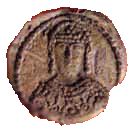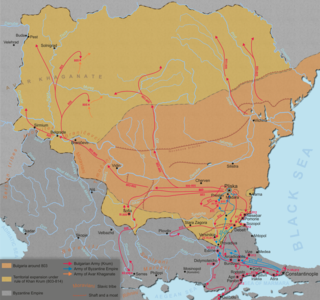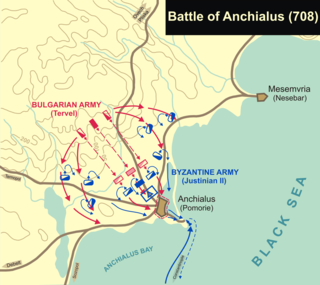
Asparuh was а ruler of Bulgars in the second half of the 7th century and is credited with the establishment of the First Bulgarian Empire in 681.

Krum, often referred to as Krum the Fearsome was the Khan of Bulgaria from sometime between 796 and 803 until his death in 814. During his reign the Bulgarian territory doubled in size, spreading from the middle Danube to the Dnieper and from Odrin to the Tatra Mountains. His able and energetic rule brought law and order to Bulgaria and developed the rudiments of state organization.
Bulgar is an extinct Oghuric Turkic language spoken by the Bulgars.

The Battle of Achelous or Acheloos, also known as the Battle of Anchialus, took place on 20 August 917, on the Achelous river near the Bulgarian Black Sea coast, close to the fortress Tuthom between Bulgarian and Byzantine forces. The Bulgarians obtained a decisive victory which not only secured the previous successes of Simeon I, but made him de facto ruler of the whole Balkan Peninsula, excluding the well-protected Byzantine capital Constantinople and the Peloponnese.

Pliska was the first capital of the First Bulgarian Empire during the Middle Ages and is now a small town in Shumen Province, on the Ludogorie plateau of the Danubian Plain, 20 km northeast of the provincial capital, Shumen.

The Second Bulgarian Empire was a medieval Bulgarian state that existed between 1185 and 1396. A successor to the First Bulgarian Empire, it reached the peak of its power under Tsars Kaloyan and Ivan Asen II before gradually being conquered by the Ottomans in the early 15th century.

The First Bulgarian Empire was a medieval state that existed in Southeastern Europe between the 7th and 11th centuries AD. It was founded in 680–681 after part of the Bulgars, led by Asparuh, moved south to the northeastern Balkans. There they secured Byzantine recognition of their right to settle south of the Danube by defeating – possibly with the help of local South Slavic tribes – the Byzantine army led by Constantine IV. During the 9th and 10th century, Bulgaria at the height of its power spread from the Danube Bend to the Black Sea and from the Dnieper River to the Adriatic Sea and became an important power in the region competing with the Byzantine Empire. It became the foremost cultural and spiritual centre of south Slavic Europe throughout most of the Middle Ages.

The Battle of Versinikia was fought in 813 between the Byzantine Empire and the Bulgarian Empire, near the city of Adrianople (Edirne) in modern-day Turkey.
The Battle of Silistra occurred in the spring of 968 near the Bulgarian town of Silistra, but most probably on the modern territory of Romania. It was fought between the armies of Bulgaria and Kievan Rus' and resulted in a Rus' victory. Upon the news of the defeat, the Bulgarian emperor Peter I abdicated. The invasion of the Rus' prince Sviatoslav was a heavy blow for the Bulgarian Empire, which by 971 lost its eastern provinces to the Byzantine Empire.

The Battle of Anchialus occurred in 708 near the modern-day town of Pomorie, Bulgaria

The Battle of Spercheios took place in 997 AD, on the shores of the Spercheios river near the city of Lamia in central Greece. It was fought between a Bulgarian army led by Tsar Samuil, which in the previous year had penetrated south into Greece, and a Byzantine army under the command of general Nikephoros Ouranos. The Byzantine victory virtually destroyed the Bulgarian army, and ended its raids in the southern Balkans and Greece. The major historical source on the battle comes from Greek historian John Skylitzes whose Synopsis of Histories contains a biography of the then-reigning Byzantine Emperor, Basil II.

The Battle of Litosoria or Lithosoria occurred between the Byzantines and Bulgars in the fall of 774 at an unknown place named Litosoria. It was located in the border area between both states, in the region of Zagore, probably north of the line Kirklareli - Vize in modern Turkey. The result was a Byzantine victory.
The battle of Thessalonica was fought between the Bulgarian and the Byzantine Empires in the summer of 1014 near the city of Thessalonica in contemporary northern Greece. The Bulgarian army under the command of Nestoritsa was defeated by the Byzantines led by the governor of Thessalonica Theophylactus Botaniates and it was unable to divert the main Byzantine forces who were attacking the Bulgarian ramparts between the Belasitsa and Ograzhden mountains.

The Battle of Philippopolis or Battle of Plovdiv took place on 30 June 1208 in the surroundings of Philippopolis between the armies of the Bulgarian Empire and the Latin Empire. The Crusaders were victorious.
The siege of Varna took place between 21 and 24 March 1201 at Varna, on the Bulgarian Black Sea coast between the Bulgarians and the Byzantines. The Bulgarians were victorious and captured the city.

The Uprising of Georgi Voyteh was a Bulgarian uprising in the Byzantine theme of Bulgaria in 1072. It was the second major attempt to restore the Bulgarian Empire after the Uprising of Peter Delyan in 1040-1041.
Isbul was the kavhan, or first minister, of the First Bulgarian Empire during the reigns of Omurtag, Malamir and Presian I. Appointed to the kavhan office under Omurtag, Isbul was a regent or co-ruler of the underage Malamir and his successor Presian.

Petar Delyan, sometimes enumerated as Petar II, was the leader of a major Bulgarian uprsing against Byzantine rule in the Theme of Bulgaria during the summer of 1040. He was proclaimed Tsar of Bulgaria, as Samuel's grandson in Belgrade, then in the theme of Bulgaria. His original name may have been simply Delyan, in which case he assumed the name Petar II upon accession, commemorating the sainted Emperor Petar I, who had died in 970. The exact year of his birth cannot be ascertained with certainty, but it is believed to have taken place during the early 11th century, likely between 1000 and 1014. Similarly, the year of his death is estimated to be 1041.
Prespa was a medieval town, situated in the homonymous area in south-western Macedonia. It was a residence and burial place of the Bulgarian emperor Samuel and according to some sources capital of the First Bulgarian Empire and seat of the Bulgarian Patriarchate in the last decades of the 10th century.
The Bulgarian–Serbian wars of 917–924 were a series of conflicts fought between the Bulgarian Empire and the Principality of Serbia as a part of the greater Byzantine–Bulgarian war of 913–927. After the Byzantine army was annihilated by the Bulgarians in the battle of Achelous, the Byzantine diplomacy incited the Principality of Serbia to attack Bulgaria from the west. The Bulgarians dealt with that threat and replaced the Serbian prince with a protégé of their own. In the following years the two empires competed for control over Serbia. In 924 the Serbs rose again, ambushed and defeated a small Bulgarian army. That turn of events provoked a major retaliatory campaign that ended with the annexation of Serbia in the end of the same year.













